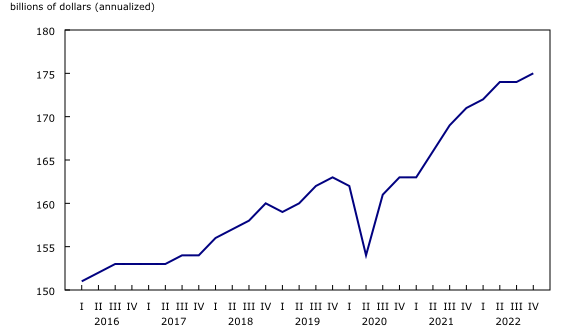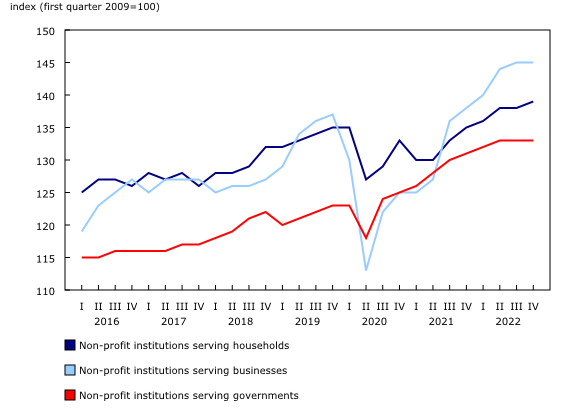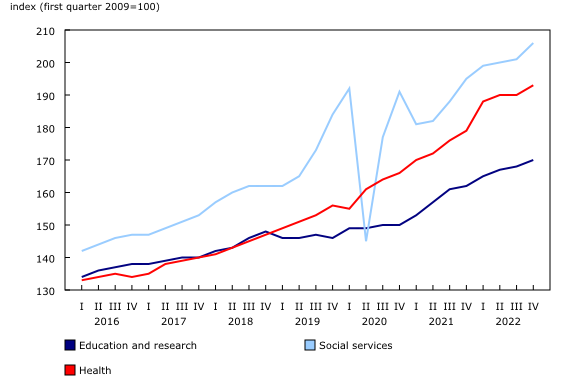Non-profit institutions and volunteering: Economic contribution, fourth quarter 2022
Released: 2023-03-29
Real gross domestic product of non-profit institutions increases
Real gross domestic product (GDP) of non-profit institutions rose 0.5% in the fourth quarter of 2022, after edging down 0.1% in the third quarter. Growth in real GDP of non-profit institutions was attributable to increased activity throughout the non-profit subsectors.
On an annual basis, the real GDP of non-profit institutions rose 3.9%, a second consecutive annual increase, following a sharp decline in 2020 when economic activities were severely affected by the COVID-19 pandemic. By contrast, economy-wide real GDP rose 3.4% in 2022 and was nearly unchanged in the fourth quarter.
Real gross domestic product of non-profit institutions serving government leads the increase
Non-profit institutions serving governments led growth in the sector, increasing 0.6% in the fourth quarter of 2022. On an annual basis, the real GDP of the subsector grew 3.1% as hospital services and post-secondary enrollment increased.
Real GDP of non-profit institutions, excluding those serving governments, grew 0.4% in the fourth quarter, the seventh consecutive quarterly increase. Real GDP of non-profit institutions serving households rose 0.5% in the fourth quarter, increasing for a seventh consecutive quarter. In 2022, non-profit institutions serving households grew 4.4%, as reliance on non-profit services by families and individuals increased.
Real GDP of non-profit institutions serving businesses rose 0.2% in the fourth quarter, with a seventh consecutively quarterly increase. In 2022, non-profit institutions serving businesses recorded the largest increase (+9.4%), which reflected the full resumption of non-profit organizations supporting businesses, such as chambers of commerce and business associations.
Employment in non-profit institutions continues to rise
Driven by higher social services and health care jobs, employment in non-profit institutions rose 0.9% in the fourth quarter of 2022, the 10th consecutive quarterly increase. Jobs in social services increased 2.5% in the fourth quarter of 2022. Compared with 2021, employment in social services rose 6.9% in 2022, among the highest growth of all activities in the non-profit sector.
Jobs in health care rose by 0.8% in the fourth quarter of 2022. Although employment has increased, job vacancies remained high among social services and health care activities.
Nominal gross domestic product rises
Combined with higher activities and increased prices, non-profit institutions' nominal GDP rose 1.4% in the fourth quarter of 2022. Price increases were led by higher post-secondary tuition fees and continued increases in health care costs. Social services (+2.5%), health care (+1.5%) and education (+1.1%) led the increase of the nominal GDP.
For non-profit institutions excluding those serving governments, nominal GDP recorded a similar increase to the third quarter of 2022, up 1.0%. Overall, non-profit institutions represented 8.4% of the economy-wide nominal GDP in the fourth quarter of 2022, while non-profit institutions excluding government represented 2.2%.
Nominal GDP of activities in social services rose for the seventh consecutive quarter, as the use of food banks and family services continued to expand since the beginning of the pandemic.
On an annual basis, nominal GDP rose 8.1% in 2022, compared with a 3.9% increase in real GDP, owing to higher prices. Activities in health care (+9.2%), education and research (+5.9%), and social services (+8.2%) recorded the largest increases in nominal GDP in 2022.
Note to readers
In this release, non-profit indicators have been revised since the first quarter of 2022. These data are directly comparable with the estimates in the Canadian System of Macroeconomic Accounts.
For the purposes of these estimates, the definition of the non-profit sector adheres to international standards published in the United Nations' Satellite Account on Non-profit and Related Institutions and Volunteer Work. Canada's overall non-profit sector is divided into the following three broad categories:
Community non-profit institutions include organizations engaged, for example, in social services, advocacy, or sports and recreation. These make up the "non-profit institutions serving households" sector in standard macroeconomic measures.
Business non-profit institutions include, for example, business associations, chambers of commerce and condominium associations. These are classified to the business sector in standard measures.
Government non-profit institutions include hospitals, some residential care facilities, universities and colleges. These are classified to the government sector in standard measures.
Products
The data visualization product "Quarterly Non-Profit Institutions Economic Account: Interactive tool," which is part of Statistics Canada – Data Visualization Products (71-607-X), is available.
As a complement to this release, the data visualization product "Annual Non-Profit Institutions Human Resource Module: Interactive tool," which is part of Statistics Canada – Data Visualization Products (71-607-X), is available.
The document "An overview of the Non-Profit Sector in Canada: 2010 to 2020," which is part of Latest Developments in the Canadian Economic Accounts (13-605-X), is available.
The Economic accounts statistics portal, accessible from the Subjects module of the Statistics Canada website, features an up-to-date portrait of national and provincial economies and their structure.
The Latest Developments in the Canadian Economic Accounts (13-605-X) is available.
The User Guide: Canadian System of Macroeconomic Accounts (13-606-G) is available.
The Methodological Guide: Canadian System of Macroeconomic Accounts (13-607-X) is available.
Contact information
For more information, or to enquire about the concepts, methods or data quality of this release, contact us (toll-free 1-800-263-1136; 514-283-8300; infostats@statcan.gc.ca) or Media Relations (statcan.mediahotline-ligneinfomedias.statcan@statcan.gc.ca).
- Date modified:




